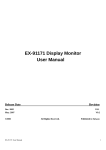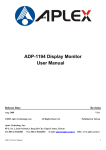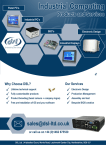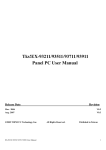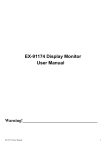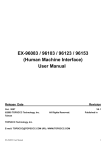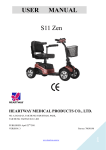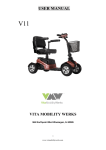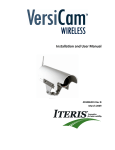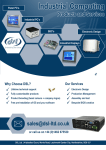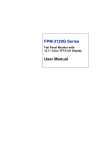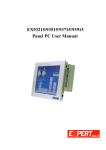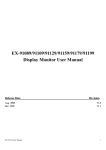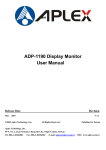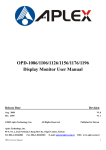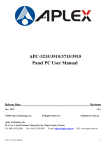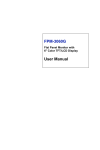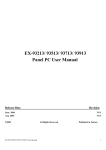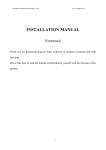Download EX-93262/EX-93562/EX-93762 Panel PC User Manual
Transcript
EX-93262/EX-93562/EX-93762 Panel PC User Manual Release Date Revision June 2005 ®2005 EX-93262/93562/93762 User Manual V0.1 All Rights Reserved. Published in Taiwan 1 Warning!___________________________________ This equipment generates, uses and can radiate radio frequency energy and if not installed and Used in accordance with the instructions manual may cause interference to radio communications. It has been tested and found to comply with the limits for a Class A computing device pursuant to FCC Rules, which are designed to provide reasonable protection against such interference when Operated in a commercial environment. Operation of this equipment in a residential area is likely To cause interference in which case the user at his own expense will be required to take whatever Measures may be required to correct the interference Electric Shock Hazard – Do not operate the workstation with its back cover removed. There are dangerous high voltages inside. Disclaimer This information in this document is subject to change without notice. EX-93262/93562/93762 User Manual 2 Table of Contents______________________ Warning!…………………………………………………………………………….……..….2 Disclaimer………………………………………………………………….…………………2 Chapter 1 Getting Started 1.1 Features…....………………….……………………………………..…...…5 1.2 Specifications………………………………………….………………...…..5 1.3 Dimensions…………………………………...…………………………......8 1.4 Block Diagram…………………………………………………………..…...9 1.5 PCI-471 Celeron M CPU Card……….……….………………………….10 1.6 Safety Precautions………………………….………………….……….…13 1.7 Brief Description of EX-93262/93562/93762………………………………13 Chapter 2 Hardware Installation 2 Installation of EX-93262/93562/93762…………………………………………15 2.1 Removal of Chassis Cover….…...…...……………………….………15 2.2 Removal of HDD Bracket...……....……………………………………15 2.3 Connecting Cable to HDD……….…...……...………………………..16 2.4 Putting HDD into Bracket………….…………………………………..16 2.5 Tightening HDD….………………….…….…..……………………..…16 2.6 Installing HDD..…….….……………………….……………………….17 2.7 Closing Chassis Cover….……………………………………………..17 2.8 Panel Mounting………………………………………………………....18 2.9 Rack Mounting……………………………………………………….....18 Chapter 3 Controller Board Installation 3.1 Introduction to PenMount 9036 Controller Board..……………………20 3.2 Features………………………..………………...………………………..20 3.3 Electrical Specifications……...……….………………………………….20 3.4 Installation of 9036 Controller Board……………………………………21 EX-93262/93562/93762 User Manual 3 Chapter 4 Software Installation 4.1 Windows 98/ME Driver Installation for 9036 Controller Board .…..…22 4.2 Uninstall PenMount Windows 98/ME Driver.…….…………………….36 4.3 Windows 2000/XP Driver Installation for 9036 Controller Board…….37 4.4 Configuring PenMount Windows 2000/XP Driver……………………..41 4.5 Uninstall PenMount Windows 2000/XP Driver………………………...51 Chapter 5 Software Functions & Descriptions 5.1 Software Functions…..…………………………………………….……52 5.2 Software Function Descriptions………………….…………………….53 Appendix A: Board Description & Specifications………………….…………..………...60 Appendix B: Controller IC Specifications…………….…………….………………..…...62 Figures Figure 1.1: Dimensions ……………………………………………………...8 Figure 1.2: Block Diagram……………………………………………………9 Figure 1.3: Front View ………………………………………………………13 Figure 1.4: Layout…..…………………………..….…………………….….14 Figure 2.1: Panelmounting………………………………………………….18 Figure 2.2: Rackmounting…………………………………………………..18 Figure 3.1: Birdeye’s View…………………………………………………..19 Figure 3.2: Mechanical Drawing…………………………………………....19 EX-93262/93562/93762 User Manual 4 Chapter 1_____________________________ 1.1 Features z EX-93262: 12.1” SVGA 800x600 display, 262K colors, 300 cd/m luminance, viewing angle of 120 (H), 95 ; EX-93562: 15” SVGA 1024x768 display, 16.2M colors, 400 cd/m luminance, viewing angle of 170 (H), 135 ; EX-93762: 17” SVGA 1280x1024 display, 16.2M colors, 300 cd/m luminance, viewing angle of 140 (H), 130 z z z z z z z z z z Front panel NEMA 4/IP 65 rating (panel-mount) Fanless design Low noise and low power consumption Resistive touch screen (optional) Ethernet 2 PCI expansion slots 2 USB 2.0 ports 4 COM ports (one is reserved for touch screen) Space for slim CD/DVD combo drive or optional CD-RW/DVD DC 12/24V wide-ranging input 1.2 Specifications System CPU: Intel® Celeron® M processor with clock rate of 600MHz (non L2 cache) Chipset: Intel® 852GM+ICH4 System Memory: DDR266 SDRAM (max. 1GB) DRAM Socket: One 200-pin SO-DIMM Hard Drive: One 2.5” slim type BIOS: Phoenix-Award 2MB PnP BIOS IDE Interface: 2 x UDMA 33/66/100 EX-93262/93562/93762 User Manual 5 CD-ROM: 1 x slim CD/DVD/Combo Drive Watchdog: 1~255 sec. watchdog timer with Reset and NMI I/O Port: Two COM ports, one SPP/ECP/EPP port, two USB2.0 ports, two PS/2 keyboard and mouse ports RJ-45 LAN Port: 2 x Realtek RTL8100 (10/100Mbps) support Wake-on-LAN with ATX power VGA: Built-in Intel® 852GM Expansion Slot: 2 x PCI slot Touch Screen (optional): Resistive EMC: FCC & CE Class A certified Display z EX-93262: 12.1” SVGA 800x600 display, 262K colors, 300 cd/m luminance, viewing angle of 120 (H), 95 ; EX-93562: 15” SVGA 1024x768 display, 16.2M colors, 400 cd/m luminance, viewing angle of 170 (H), 135 ; EX-93762: 17” SVGA 1280x1024 display, 16.2M colors, 300 cd/m luminance, viewing angle of 170 (H), 135 Mechanical Construction: Heavy-duty steel chassis, NEMA 4/IP65 rated front panel (panel-mount) Front Panel Color: Beige Dimensions: EX-93262: 390(W) x 102(D) x 264mm(H) EX-93562: 410(W) x 106(D) x 310mm(H) EX-93762: 457(W) x 114(D) x 355mm(H) Weight: EX-93262: 6.45kgs EX-93562: 7.48kgs EX-93762: 8.68kgs EX-93262/93562/93762 User Manual 6 Power Supply: 12V/24V DC input 60W ATX PSU Environment Operating temperature: 0~50 C Storage temperature: -10 C ~ 75 C Relative humidity: 10~90% @ 40 C non-condensing Vibration: 5~17Hz, 0.1” double amplitude displacement 17~640Hz, 1.5G acceleration peak to peak Shock: 10G acceleration peak to peak (11 millimeters) Ordering Information z EX-93262/EX-93562/EX-93762 Barebone w/Celeron® M 600MHz processor w/o HDD, RAM and CD-ROM z EX-93262-T/EX-93562-T/EX-93762-T Barebone w/Celeron® M 600MHz processor & resistive touch screen w/o HDD, RAM and CD-ROM z EX-93262-S/EX-93562-S/EX-93762-S Celeron M 600MHz processor, 256MB DDR SO-DIMM, 40GB HDD, slim combo DVD w/o touch z EX-93262-ST/EX-93562-ST/EX-93762-ST Celeron M 600MHz processor, resistive touch screen, 256MB DDR SO-DIMM, 40GB HDD, slim combo DVD EX-93262/93562/93762 User Manual 7 1.3 Dimensions Figure 1.1: Dimensions of the EX-93262 Note: Structures of the EX-93562 and EX-93762 are the same as that of the EX-93262 shown above except for the dimensions which are 410(W) by 106(D) by 310mm(H) and 457(W) by 114(D) by 355mm(H), respectively. EX-93262/93562/93762 User Manual 8 1.4 Block Diagram Figure 1.2: Block Diagram of the EX-93262/EX-93562/EX-93762 EX-93262/93562/93762 User Manual 9 1.5 EX-9472 Celeron® M CPU Card (for the EX-93262, EX-93562 and EX-93762) Specifications System CPU: Intel® Celeron® M processor CPU Frequency: ULV 600MHz (non L2 cache) Chipset: Intel® 852GM + ICH4 DRAM: One 200-pin DDR SO-DIMM supporting DDR266 SDRAM up to 1GB BIOS: Phoenix-Award PnP BIOS with VGA BIOS Watchdog: 1~255 secs watchdog timer selectable w/Reset/NMI EX-93262/93562/93762 User Manual 10 Power Supply: Support ATX power Power Requirements: +5V, +12V, -12V, +5VSB Dimensions: 170mm x 170mm (6.69 x 6.69 inches) I/O Ports IDE Interface: One 40-pin IDE (UDMA 33/66/100) CF: One Compact flash slot (IDE) FDD Interface: One FDD Bus Interface: PCI slot, mini-PCI bus Serial Port: Four COM ports: COM1 and 4 for RS232 and COM2 and for RS232/422/485 (for 16550 compatible type of UART) Parallel Port: One parallel (SPP/EPP/ECP) IrDA: 1 (SIR) Keyboard: Mini DIN connector Mouse: Mini DIN connector LAN: Realtek RTL8100C (10/100Mbps) EX-93262/93562/93762 User Manual 11 Support Wake-on with ATX power USB: Six USB 2.0 Display Graphics: Built-in Intel® 852GM sharing system memory and supporting CRT, LVDS LCD Interface: 18-/36-bit LVDS Environment Operating Temperature: 0 ~ 60 C (32 ~ 140 F) Storage Temperature: -40 Operating Humidity: 20~90% Storage Humidity: 20~95% EX-93262/93562/93762 User Manual 12 1.6 Safety Precautions Follow the messages below to avoid your systems from damage: * Avoid your system from static electricity on all occasions. * Prevent electric shock. Don‘t touch any components of this card when the card is power-on. Always disconnect power when the system is not in use. *Disconnect power when you change any hardware devices. For instance, when you connect a jumper or install any cards, a surge of power may damage the electronic components or the whole system. 1.7 Brief Description of the EX-93262, EX-93562 and EX-93762 The EX-93262, EX-93562 and EX-93762 are rugged and compact panel-mount industrial fanless PCs, which come with a 12.1-inch (300 cd/m ), 15-inch (400 cd/m ), and 17-inch (300 cd/m ) TFT LCD, respectively. They are powered by an Intel® Celeron® M processor and offer optimal heat dissipation and low-power consumption without sacrifice of speed performance. These industrial panel PCs also feature 2 PCI expansion slots, 4 COM ports and slim CD/DVD combo drive, and support 2 USB 2.0 ports. They come with 12/24V DC power input. They are ideal for use as a PC-based controller for Automotive, Logistic Process, Materials Handling, and Kiosk applications. Figure 1.3: Front View of EX-93262/93562/93762 EX-93262/93562/93762 User Manual 13 Figure 1.4: I/O Layout of EX-93262/93562/93762 EX-93262/93562/93762 User Manual 14 Chapter 2_____________________________ 2 Installation of the EX-93262/93562/93762 Touch Panel Computer 2.1 Removal of Chassis Cover There are 7 screws to deal with when enclosing or removing the chassis. Six are along the three sides of the chassis as shown in the picture by the arrows while one circled is on the top. 2.2 Removal of HDD Bracket To remove the HDD bracket from its position, just unscrew the 4 screws as shown in the picture. EX-93262/93562/93762 User Manual 15 2.3 Connecting Cable to HDD Connect the cable to the HDD, making sure that the red stripe of the cable is on the right side (if connected with the top of the HDD facing upward). 2.4 Putting HDD into Bracket Place the HDD into the base of the bracket as shown in the picture. 2.5 Tightening HDD Tightly fasten the four screws as circled to secure the HDD. EX-93262/93562/93762 User Manual 16 2.6 Installing HDD Get the 4 screws tightened onto the chassis as shown in the picture. 2.7 Closing Chassis Cover To finish the job, just fasten the 7 screws as shown in the picture. EX-93262/93562/93762 User Manual 17 2.8 Panel Mounting The EX-93262/93562/93762 panel PC is designed to be panel-mounted as shown in Figure 2.1. Just carefully place the unit through the hole and tighten the given 8 screws from the rear to secure the mounting. Figure 2.1: Panelmounting of the EX-93262/93562/93762 2.9 Rack Mounting (optional) The EX-93262/93562/93762 panel PC can be rack-mounted as an option. Just carefully slide it into the rack and tighten the given 8 screws from the front to secure the mounting as shown in Figure 2.2. Figure 2.2: Rackmounting of the EX-93262/93562/93762 EX-93262/93562/93762 User Manual 18 Chapter 3_____________________________ 3.1 Introduction to the PenMount 9036 Controller Board The PenMount 9036 control board is configured for use with the RS-232 interface. It connects to the touch screen, power supply and computer system’s RS-232 port, and supports 4-, 5- and 8-wire touch screens. The control board has some advanced functions, such as PnP and non-PnP mode adjustable baud rate, thus making easy for customers to select different touch screens without changing the control board. The size of the board is 25 by 60mm, and it has two connectors and one dipswitch on-board. Figure 3.1: Bird’s Eye View of PenMount 9036 Figure 3.2: Mechanical Drawing of PenMount 9036 EX-93262/93562/93762 User Manual 19 3.2 Features z z z z z z z z z z z z z z RS-232 interface Touch controller is DMC9000 Design for the best touch performance and easy configuration PnP or Non-PnP mode selectable Design for best cost arrangement Supporting 2048x2048 pen device resolution 19200 or 9600 baud rate transmission selectable Upgraded noise handling mechanism (3 level scheme) Fixed and high-speed sampling rate 4-, 5- and 8-wire touch screen supported Touch screen cable, RS-232 with power cable connectors onboard 5V to 12V power input Circuit protection for input voltage Touch-activated LED indicator onboard 3.3 Electrical Specifications Touch Screen: 4-, 5- and 8-wire analog resistive type Touch Screen Controller: DMC9000 Communications: RS-232 Baud Rate: 19200 and 9600 baud rate selection Resolution: 1024x1024 (10-bit A/D converter inside) Power Input: 5V ~ 12V DC Power Consumption: 12V: 24mA+ i where (i=v/touch screen sheet R) 5V: 20mA+ i where (i=v/touch screen sheet R) EX-93262/93562/93762 User Manual 20 Board Size: 6.0 x 2.5cm Portrait: Support 90 to 279 screen rotation Static Protection: ESD device (optional) 3.4 Installation of the 9036 Controller Board Follow the steps below to install the 9036 control board: 1. Power down your computer and display, and open your display or system case. Find space on your system and attach the control board to your system with screws. The control board has industry standard 3 screw holes. 2. Find the white 6-pin right-angle connector (on the left in the image above [see Figure 3.1]). The power cable is pin 1 and pin 2. Solder the power and ground wire to the system. The RS-232 cable is for pins 3 to 6. Attach the RS-232 cable’s D-sub connector to a COM port at the back of the computer. 3. Find the white 9-pin right-angle connector (on the right in the image above [see Figure 3.1]). Attach the female end of the touch screen cable to this connector. If you attach the cable of a 4-/5-/8-wire touch screen to pins 1~5/1~6/1~9, attach the male end of the cable to the touch screen tail. 4. Mount your touch screen to the display. 5. Find the onboard DIP switch (on the upper right of the image above [see Figure 3.1]). This switch selects baud rate, PnP or non-PnP mode, and touch screen type. Set the DIP switch to configure your control board according to the definitions and settings of the table below: Switch Definition ON OFF S1 Baud Rate Adjustment 9600 19200 S2 PnP enable or disable Disable Enable S3 Touch screen type 5-wire 4-, 8-wire S4 Touch screen type 4-, 8-wire 5-wire 6. Turn on power to the computer and the display. 7. Install the software drivers and utilities and calibrate the touch screen. EX-93262/93562/93762 User Manual 21 Chapter 4_____________________________ 4.1 Windows 98/ME Driver Installation for 9036 Controller Board Before installing the Windows 98/ME driver software, you must have the Windows 98/ME system installed and running on your computer. You must also have the 9036 PenMount Serial Interface controller board installed. Contents of the PenMount Windows 98/ME driver folder are listed below: SETUP.EXE DMC9000.INF DMC9000.VXD If you have an older version of the PenMount Windows 98/ME driver installed in your system, please remove it first. Follow the steps below to install the PenMount Windows 98/Me driver. 1. When the system first detects the controller board, a screen appears that shows “Unknown Device.” Do not use this hardware wizard. Press Cancel. EX-93262/93562/93762 User Manual 22 2. Install the PenMount Windows 98/ME driver onto your system from the CD-ROM: 3. A welcome message for the PenMount utilities setup program appears. Select “Next”. EX-93262/93562/93762 User Manual 23 4. The Software License Agreement screen appears. Select "Yes". 5. The Information screen appears. Select "Next". EX-93262/93562/93762 User Manual 24 6. The Choose Destination Location screen appears. This installs PenMount Utilities in the folder: C:\Program Files\PenMount\Win9x. Select "Next” or modify the folder name to the one you would like to use. 7. The Select Program Folder screen appears. The default is "PenMount Utilities". Select "Next” or change it. EX-93262/93562/93762 User Manual 25 8. The Start Copying Files screen appears. Select "Next" to copy files to the system. 9. The Setup Complete screen appears. Select "Finish". EX-93262/93562/93762 User Manual 26 10. The “Restarting Windows” screen appears, choose “Yes, I want to restart my computer now,” and “OK.” Configuring the PenMount Windows 98/Me Driver Upon restarting, the computer automatically finds the new 9000 controller board. The touch screen is connected but not calibrated. Follow the procedures below to carry out calibration. 1. After installation, click the PenMount Monitor icon “PM” in the menu bar. 2. When the PenMount Control Panel appears, click “Calibrate.” PenMount Control Panel The functions of the PenMount Control Panel are explained in the following sections. Calibrate This function offers two ways to calibrate your touch screen. ‘Standard Calibration’ adjusts most touch screens. ‘Advanced Calibration’ adjusts aging touch screens. Standard Calibration Click this button and arrows appear pointing to red squares. Use your finger or stylus to touch the red squares in sequence. After the fifth red point calibration is complete. To skip, press ‘ESC’. Advanced Calibration Advanced Calibration uses 4, 9, 16 or 25 points to effectively calibrate touch panel linearity of aged touch screens. Click this button and touch the red squares in sequence with a stylus. To skip, press ESC’. EX-93262/93562/93762 User Manual 27 NOTE: The older the touch screen is, the more Advanced Mode calibration points you need for an accurate calibration. Use a stylus during Advanced Calibration for greater accuracy. EX-93262/93562/93762 User Manual 28 Plot Calibration Data EX-93262/93562/93762 User Manual Check this function and a touch panel linearity comparison graph appears when you have finished Advanced Calibration. The blue lines show linearity before calibration and black lines show linearity after calibration. 29 Draw Tests or demonstrates the PenMount touch screen operation. The display shows touch location. Click Draw to start. EX-93262/93562/93762 User Manual 30 Touch the screen with your finger or a stylus and the drawing screen will register touch activity such as left, right, up, down, pen up, and pen down. Click Clear Screen to clear the drawing. EX-93262/93562/93762 User Manual 31 Option This panel function supports two modes—Operation Mode and Beep Sound Mode—which allow configuration for specific touch screen applications, such as point-of-sales (POS) terminals. Operation Mode This mode enables and disables the mouse’s ability to drag on-screen icons—useful for configuring POS terminals. Stream Mode – Select this mode and the mouse functions as normal and allows dragging of icons. Point Mode – Select this mode and the mouse only provides a click function, and dragging is disabled. Beep Sound Mode Enable Beep Sound – turns beep function on and off Beep on Pen Down – beep occurs when pen comes down Beep on Pen Up – beep occurs when pen is lifted up Beep on both of Pen Down/Up – beep occurs on both Beep Frequency – modifies sound frequency Beep Duration – modifies sound duration ` EX-93262/93562/93762 User Manual 32 About This panel displays information about the PenMount controller and this driver version. PenMount Monitor Menu Icon The PenMount monitor icon (PM) appears in the menu bar of Windows 98/ME system when you turn on the PenMount Monitor in the PenMount Utilities. The PenMount Monitor has the following functions: EX-93262/93562/93762 User Manual 33 Right Click Button When you select this function, a mouse icon appears in the right-bottom of the screen. Click this icon to switch between Right and Left Button functions. Beep Sound Turns beep on or off. Enable PNP Turns PNP on or off. When this is unchecked, PNP is off. The RS-232 transfer signal is continuous when the cable is unplugged and plugged into the serial port. Exit Exits the PenMount Monitor function. PenMount Rotating Functions The PenMount driver for Windows 98/ME supports several display rotating software packages. The PenMount drivers for Windows 95, Windows 98/ME, Windows 2000/XP, as well as Windows 98 USB and Windows ME/2000/XP support display rotating software packages such as: • Portrait’s Pivot Screen Rotation Software • ATI Display Driver Rotate Function • nVidia Display Driver Rotate Function • SMI Display Driver Rotate Function • Intel 845G/GE Display Driver Rotate Function EX-93262/93562/93762 User Manual 34 Configuring the Rotation Function 1. Install the rotation software package. 2. Choose the rotating function (0°, 90°, 180°, 270°) in the 3rd party software. The calibration screen appears automatically. Touch this point and rotation is mapped. NOTE: The Rotating function is disabled if you use Monitor Mapping EX-93262/93562/93762 User Manual 35 4.2 Uninstall the PenMount Windows 98/ME Driver 1. Exit the PenMount monitor (PM) in the menu bar. 2. From “PenMount Utilities” in “Programs”, select the “Uninstall” utility 3. This message appears: “Are you sure you want to completely remove ‘PenMount Utilities’ and all its components?” 4. Select “Yes” to remove the PenMount Windows 98/ME driver. 5. Reboot system and the PenMount Windows 98/ME driver is removed from system. EX-93262/93562/93762 User Manual 36 4.3 Windows 2000/XP Driver Installation for 9036 Control Board Before installing the Windows 2000/XP driver software, you must have the Windows 2000/XP system installed and running on your computer. You must also have the 9036 PenMount Serial Interface controller board installed. Contents of the PenMount Windows 2000/XP driver folder are listed below: DMC9000.inf DMC9000.sys DMC9000.cat SETUP.EXE If you have an older version of the PenMount Windows 2000/XP driver installed in your system, please remove it first. Follow the steps below to install the PenMount Windows 2000/XP driver. 1. When the system first detects the controller board, a screen appears that shows “Unknown Device”. Do not use this hardware wizard. Press Cancel. EX-93262/93562/93762 User Manual 37 2. Insert the PenMount Driver CD-ROM. Go to the Windows 2000-XP Driver folder. Click setup.exe. 3. The screen displays the installation wizard for the PenMount software. Click “Next”. EX-93262/93562/93762 User Manual 38 3. A License Agreement appears. Click “I accept…” and “Next”. 4. The “Ready to Install the Program” screen appears. Select “Install”. EX-93262/93562/93762 User Manual 39 5. The next screen is “Hardware Installation”. Select “Continue Anyway”. 6. The “InstallShield Wizard Completed” appears. Click “Finish”. EX-93262/93562/93762 User Manual 40 4.4 Configuring the PenMount Windows 2000/XP Driver Upon rebooting, the computer automatically finds the new 9036 controller board. The touch screen is connected but not calibrated. Follow the procedures below to carry out calibration. 1. After installation, click the PenMount Monitor icon “PM” in the menu bar. 2. When the PenMount Control Panel appears, click “Calibrate”. PenMount Control Panel The functions of the PenMount Control Panel are Calibrate, Draw, Multiple Monitors, Option, and About, which are explained in the following sections. Calibrate This function offers two ways to calibrate your touch screen. “Standard Calibration” adjusts most touch screens. “Advanced Calibration” adjusts aging touch screens. Standard Calibration Click this button and arrows appear pointing to red squares. Use your finger or stylus to touch the red squares in sequence. After the fifth red point calibration is complete. To skip, press ‘ESC’. Advanced Calibration Advanced Calibration uses 4, 9, 16 or 25 points to effectively calibrate touch panel linearity of aged touch screens. Click this button and touch the red squares in sequence with a stylus. To skip, press ‘ESC’. EX-93262/93562/93762 User Manual 41 NOTE: The older the touch screen is, the more Advanced Mode calibration points you need for an accurate calibration. Use a stylus during Advanced Calibration for greater accuracy. EX-93262/93562/93762 User Manual 42 Plot Calibration Data EX-93262/93562/93762 User Manual Check this function and a touch panel linearity comparison graph appears when you have finished Advanced Calibration. The blue lines show linearity before calibration and black lines show linearity after calibration. 43 Draw Tests or demonstrates the PenMount touch screen operation. The display shows touch location. Click Draw to start. Touch the screen with your finger or a stylus and the drawing screen will register touch activity such as left, right, up, down, pen up, and pen down. Touch the screen with your finger or a stylus and the drawing screen will register touch activity such as left, right, up, down, pen up, and pen down. EX-93262/93562/93762 User Manual 44 Click Clear Screen to clear the drawing. Multiple Monitors Multiple Monitors support from two to six touch screen displays for one system. The PenMount drivers for Windows 2000/XP support Multiple Monitors. This function supports from two to six touch screen displays for one system. Each monitor requires its own PenMount touch screen control board, either installed inside the display or in a central unit. The PenMount control boards must be connected to the computer COM ports via the RS-232 interface. Driver installation procedures are the same as for a single monitor. Multiple Monitors support the following modes: Windows Extends Monitor Function Matrox DualHead Multi-Screen Function nVidia nView Function NOTE: The Multiple Monitor function is for use with multiple displays only. Do not use this function if you have only one touch screen display. Please note once you turn on this function the rotating function is disabled. EX-93262/93562/93762 User Manual 45 Enable the multiple display function as follows: 1. Check the Enable Multiple Monitor Support box; then click Map Touch Screens to assign touch controllers to displays. 2. When the mapping screen message appears, click OK. EX-93262/93562/93762 User Manual 46 3. Touch each screen as it displays “Please touch this monitor”. Following this sequence and touching each screen is called mapping the touch screens. 4. Touching all screens completes the mapping and the desktop reappears on the monitors. 5. Select a display and execute the “Calibration” function. A message to start calibration appears. Click OK. 6. “Touch this screen to start its calibration” appears on one of the screens. Touch the screen. 7. “Touch the red square” messages appear. Touch the red squares in sequence. 8. Continue calibration for each monitor by clicking Standard Calibration and touching the red squares. NOTES: 1. If you use a single VGA output for multiple monitors, please do not use the Multiple Monitor function. Just follow the regular procedure for calibration on each of your desktop monitors. 2. The Rotating function is disabled if you use the Multiple Monitor function. 3. If you change the resolution of display or screen address, you have to redo Map Touch Screens, so the system understands where the displays are. EX-93262/93562/93762 User Manual 47 About This panel displays information about the PenMount controller and this driver version. PenMount Monitor Menu Icon The PenMount monitor icon (PM) appears in the menu bar of Windows 2000/XP system when you turn on the PenMount Monitor in the PenMount Utilities. The PenMount Monitor has the following functions: EX-93262/93562/93762 User Manual 48 Beep Turns beep on or off. Right Button When you select this function, a mouse icon appears in the right-bottom of the screen. Click this icon to switch between Right and Left Button functions. Pen Stabilizer Check this function to reduce cursor vibration for relatively unstable touch screens, or where there may be excess vibration. Normally this function is not checked. Exit Exits the PenMount Monitor function. EX-93262/93562/93762 User Manual 49 PenMount Rotation Functions The PenMount driver for Windows 2000/XP supports several display rotating software packages. The PenMount drivers for Windows 95, Windows 98/ME, Windows 2000/XP, as well as Windows 98 USB and Windows Me/2000/XP support display rotating software packages such as: • Portrait’s Pivot Screen Rotation Software • ATI Display Driver Rotating Function • nVidia Display Driver Rotating Function • SMI Display Driver Rotating Function • Intel 845G/GE Display Driver Rotating Function Configuring the Rotation Function 1. Install the rotation software package. 2. Choose the rotating function (0°, 90°, 180°, 270°) in the 3rd party software. The calibration screen appears automatically. Touch this point and rotation is mapped. NOTE: The rotating function is disabled if you use Monitor Mapping EX-93262/93562/93762 User Manual 50 4.5 Uninstall the PenMount Windows 2000/XP Driver 1. Exit the PenMount monitor (PM) in the menu bar. 2. Go to Settings, then Control Panel, and then click Add/Remove program. Select PenMount DMC9000 and click the Add/Remove button. 3. Select PenMount DMC9000 and DMC9100. Click the Remove button. 4. Select “Yes” and “Close” to remove the PenMount Windows 2000/XP driver, and reboot the system. EX-93262/93562/93762 User Manual 51 Chapter 5_____________________________ 5.1 Software Functions This chapter describes the special software functions that configure and adjust the PenMount controller board and touch screen hardware. Please note that not all of the functions are available for every driver. Software functions and their availability for specific interface and systems are shown in the table below—a description for each function follows: Software Function Standard Calibration DOS Win 3.1 95 98/Me NT 2000/XP CE Linux QNX ● ● ● Advanced Calibration ●■ ● ●■ ●■ ●■ ● ●■ ●■ ■ Multi Device ● Rotation ●■ ●■ ● ●■ Stream/Point mode ● ●■ ● ● ● ●■ ● ●■ Beep Sound ● ● ● ●■ ● ●■ Beep sound adjustable ●■ ●■ Wake up function ●■ ■ Showing linearity ●■ ●■ Right button ● ● ● ● ● ● ● ● Double click area and speed adjustable ● ■ ●■ ● ● ●■ ●■ ■ ●■ Drawing mode About ● ● Multiple Monitors Hide cursor ●■ ● ● ●■ ●■ ●■ ● ●■ RS-232 Interface (9000 series) USB Interface (5000 series) EX-93262/93562/93762 User Manual 52 5.2 Software Function Description Description for each of the software functions shown in the table above follows: Standard Calibration The Standard Calibration function lets you match the touch screen to your display so that the point you touch is accurately tracked on screen. Standard calibration only requires four points for calibration and one point for confirmation. Under normal circumstances, Standard Calibration is all you need to perform an accurate calibration. Advanced Calibration The Advanced Calibration function improves the accuracy of calibration by using more involved engineering calculations. Use this function only if you have tried the Standard Calibration and there is still a discrepancy in the way the touch screen maps to the display. You can choose 4, 9, 16 or 25 points to calibrate, though we suggest that you first try 9 points, if it is still not tracking well then try 16 or 25 points. The more points you use for calibration, the greater the accuracy. Errors in calibration may occur due to viewing angle, or individual skill, and there may be little difference in using 16 or 25 points. Note that a stylus is recommended for the most accurate results. Multiple Monitors Until now most touch screen systems only support one monitor, and users of multiple monitors have not been able to use touch screen systems. This situation has inspired PenMount to design and develop Multiple Monitors support using the PenMount 9036 control board and Windows 2000/XP driver. Our advanced design supports from 2 to 6 monitors that can be split horizontally or vertically. Requirements Before using the Multiple Monitor function, you need the following: 1. A display card that supports multiple monitors such as the Matrox, nVidia, ATI, etc. (Two or more display cards supported by Windows are also OK.) 2. Two or more touch screens 3. Two or more serial ports 4. Two or more PenMount 9000 control boards such as the 9036, 9026, 9084, or 90A4 5. The PenMount 9000 Windows 2000/XP v4.01 or greater software driver Before using Multiple Monitors you must have two or more monitors that are in extension mode. For display cards that support multiple monitors, we suggest you consider Matrox, EX-93262/93562/93762 User Manual 53 nVidia, or ATI cards and inquire about operation and usability issues. Note: Before you can use multiple monitors, you need to map each monitor. Multiple Devices The Multiple Devices function is designed to let you use two or more monitors to display the same image. Software that supports this function includes the PenMount 9000 2000/XP drivers and the PenMount 5000 98/Me/2000/XP/CE drivers. The drivers for PenMount 9000 can support up to six control boards, and the drivers for PenMount 5000 support up to 16 Comparing Functions The difference between the Multiple Monitors function and the Multiple Devices function are illustrated below: or The Multiple Monitors function shown above extends the screen into 2 or more monitors. EX-93262/93562/93762 User Manual 54 The Multiple Devices function displays the same image on two or more monitors. Requirements Before using the Multiple Monitors function, you need the following: 1. A display card that supports Dual Monitors such as the Matrox, nVidia, ATI, etc., or that outputs into a 1-into-2 VGA signal box 2. Two or more touch screens 3. Two or more serial ports or USB ports 4. Two or more PenMount 9000 control boards such as the 9036, 9026, 9084, or 90A4, or PenMount 5000 control boards such as the 5184 or 51A5 5. If using the PenMount 9000 control board the driver must be the PenMount 9000 Windows 2000/XP v4.01 or greater software driver 6. If using the PenMount 5000 control board the driver must be for Windows 98/ME/2000/XP/CE 9000 Control Boards To use multiple devices with 9000 Control Boards: 1. Configure your computer hardware. 2. Attach each 9000 Control Board to a different computer’s serial port. 3. Install the appropriate PenMount software driver in each computer. 4. Use each driver’s Calibration function to calibrate each computer’s touch screen. You must calibrate each touch screen before configuration is complete. Rotation There are currently a number of software packages on the market that support rotating monitors 0°, 90°, 180°, and 270°. However, you will not be able to use a touch screen unless it is matched to the appropriate rotation. Our rotation configuration function allows you to easily match the touch screen when you rotate your monitor. If you use a rotating monitor, you will need a display card such as from nVidia, Intel, SMI or ATI and software such as Portrait Pivot Pro. For software operation and features, please refer to your software manual. Configuring the rotation function is easy. Select this option and a ‘point’ appears for you EX-93262/93562/93762 User Manual 55 to touch. Once the point is touched, the software driver understands which degree you plan to rotate your display. The rotation function supports 90, 180 and 270 degrees rotation. 0 degrees EX-93262/93562/93762 User Manual 56 90 degrees 180 degrees 270 degrees EX-93262/93562/93762 User Manual 57 Stream/Point Mode Stream and point modes control the touch and drag function of the touch screen. The point mode only allows “touch” interaction with the screen and does not allow the user to drag objects. The point mode is useful for maintaining the location of screen icons such on POS terminals. The stream mode allows a user to touch and drag icons and other items around on the screen, similar to using a mouse. Drawing Mode Drawing mode is a utility that lets the user draw on the screen using a finger or stylus. This allows the user to test the touch screen and touch controller to see if it is operational or is mapped correctly. The drawing mode can display either the matrix address of points touched or just show lines drawn. One of the PenMount driver’s strengths is a special mathematical algorithm that minimizes the occurrence of noise and smooths the drawing of lines. Beep Sound All of PenMount’s drivers support the beep sound function; however, some PC systems may only offer a fixed buzzer sound. Beep Sound Adjustable Software drivers for Windows systems let the user adjust the frequency and length of the beep sound. The drivers let the user adjust the desired touch screen sound, as well as turn the sound off. Wake Up Function The Wake Up function lets the user touch the screen and wake the system up from ‘suspend’ mode. Point Calibration Data The Plot Calibration Data function displays the touch screen linearity map, which is available if the PenMount driver provides an Advance Calibration function when touch screens age their touch linearity declines. This non-linearity is apparent when the touched point on the touch screen is not the same as the point on the display. The plot calibration data function shows the linearity status of the touch screen. This is only a support function for the user. The exact linearity of a touch screen requires a linearity test machine. EX-93262/93562/93762 User Manual 58 Right Button The Right Button function simulates the right button function of a mouse. Click the right button and the user can only touch the screen once and the driver changes the touch definition to the left button. Hide Cursor The Hide Cursor function keeps the cursor arrow and other cursor symbols from appearing when using the touch screen. The cursor appears when the user turns this function off. Cursor Offset The Cursor Offset function lets the user adjust the position of the touch point to a desired location away from the real touch point. Double-Click Area and Speed The Double-Click Area and Speed function lets the user adjust the double-click area and speed to their personal preference. About This option shows the exact version of the drivers and controller firmware. Updated drivers are available for download on the PenMount website. EX-93262/93562/93762 User Manual 59 Appendix A: Board Descriptions & Specifications This appendix provides information on controller board features and specifications. PenMount 9036 Control Board The PenMount 9036 control board is configured for the RS-232 interface and it supports 4-wire, 5-wire and 8-wire touch screens. PenMount 9036 Features • • • • • • • • DMC9000 touch controller Diagnostic LED on board Supports PnP and non-PnP mode Supports 4-wire, 5-wire and 8-wire touch screen Baud rate 19200 or 9600 bps selectable Automatic pin assignment adjustment Input voltage is 5V to 12V Bundled with PenMount drivers, which are also available for download from our website Connector Pin Definitions Pin definitions for the two connectors on the PenMount 9036 control board follow: Connector Pin Definitions for Touch Screen Pin definition 4-wire 5-wire / wires touch screen touch screen PIN 9 N/A N/A PIN 8 N/A N/A PIN 7 N/A N/A PIN 6 N/A Sense PIN 5 Right LR PIN 4 Left LL PIN 3 Bottom UR PIN 2 Top UL PIN 1 Ground Ground EX-93262/93562/93762 User Manual 8-wire touch screen Right Sense Left Sense Bottom Sense Top Sense Right Left Bottom Top Ground 60 Connector Pin Definitions for Power and RS-232 Power Lines RS-232 Pin # PIN 1 PIN 2 PIN 3 PIN 4 Definition Ground 5V~12V power RTS TXD EX-93262/93562/93762 User Manual Interface PIN 5 RXD PIN 6 Ground 61 Appendix B: Controller IC Specifications This appendix offers information on touch screen controller IC features and specs. PenMount DMC9000 Touch Screen Controller IC The PenMount DMC9000 is the best-performance touch screen controller. Designed with PnP features for new system trends, it offers RS-232 touch screen interface. The DMC9000 is designed for those who need an all-in-one solution with a built-in A/D converter for a denser total printed circuit board. Electrical Specifications Touch Screen: 4, 5 & 8 wire Package: 28-pin PDIP or 32-pin TQFP Communications: RS-232 Characteristics: 8-bit RISC microprocessor with built-in functions including 10-bit ADC, UART, Timer, Counter, Comparator, Watchdog, Memory, etc. Voltage Range: + 4.0V to +6.0V Power Consumption: Active: 3.4 mA / Idle Mode: 1.4mA (at 4 MHz, 3V) Power Down Mode: <1 µA Operating Temperature: -40o C to +85o C Storage Temperature: -65o C to +150o C Volt. on RESET with respect to Ground: -1.0V to +13.0V DC Current per I/O Pin: 40.0 mA DC Current Vcc and GND Pins: 300.0 mA Driver Software DOS, Windows 3.11, Windows 95/98/ME, Windows NT/2000/XP, Linux, QNX, Windows CE (for both X86 and SA CPUs) EX-93262/93562/93762 User Manual 62






























































